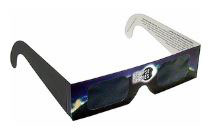Safety - Eclipse
Eye Safety During an Annular Eclipse
A crowd uses handheld solar viewers and solar eclipse glasses to safely view a solar eclipse. Credit: National Park Service.
The Sun is never completely blocked by the Moon during an annular solar eclipse. Therefore, during an annular eclipse, it is never safe to look directly at the Sun without specialized eye protection designed for solar viewing.
Viewing any part of the bright Sun through a camera lens, binoculars, or a telescope without a special-purpose solar filter secured over the front of the optics will instantly cause severe eye injury.
Protective Equipment for the Eclipse

When watching an annular solar eclipse directly with your eyes, you must look through safe solar viewing glasses (“eclipse glasses” - see example at left) or a safe handheld solar viewer at all times. Eclipse glasses are NOT regular sunglasses; regular sunglasses, no matter how dark, are not safe for viewing the Sun. Safe solar viewers are thousands of times darker and must comply with the ISO 12312-2 international standard.
Always inspect your eclipse glasses or handheld viewer before use; if torn, scratched, or otherwise damaged, discard the device. Always supervise children using solar viewers.
Do NOT look at the Sun through a camera lens, telescope, binoculars, or any other optical device while wearing eclipse glasses or using a handheld solar viewer — the concentrated solar rays will burn through the filter and cause serious eye injury.
If you don’t have eclipse glasses or a handheld solar viewer, you can use an indirect viewing method, which does not involve looking directly at the Sun. One way is to use a pinhole projector, which has a small opening (for example, a hole punched in an index card) and projects an image of the Sun onto a nearby surface. With the Sun at your back, you can then safely view the projected image. Do NOT look at the Sun through the pinhole!
Right: The circular holes of a colander project crescent shapes onto the ground during the partial phases of a solar eclipse. Credits: Joy Ng
You can make your own eclipse projector using a cardboard box, a white sheet of paper, tape, scissors, and aluminum foil. With the Sun behind you, sunlight will stream through a pinhole punched into aluminum foil taped over a hole in one side of the box. During the partial phases of a solar eclipse, this will project a crescent Sun onto a white sheet of paper taped to the inside of the box. Look into the box through another hole cut into the box to see the projected image. Credits: NASA
Do NOT use eclipse glasses or handheld viewers with cameras, binoculars, or telescopes. Those require different types of solar filters. When viewing a partial or annular eclipse through cameras, binoculars, or telescopes equipped with proper solar filters, you do not need to wear eclipse glasses. (The solar filters do the same job as the eclipse glasses to protect your eyes.)
A woman looks at the Sun through binoculars that have been fitted with solar filters. Binoculars and telescopes can only be used to look at the Sun when used with solar filters specially designed for that purpose. Credits: NASA/Ryan Milligan
Seek expert advice from an astronomer before using a solar filter with a camera, telescope, binoculars, or any other optical device. Note that solar filters must be attached to the front of any telescope, binoculars, camera lens, or other optics.
A solar filter is attached to the Sun-facing end of a telescope. Credits: Carolyn Slivinski
For additional safety tips about skin safety in the sun, extreme heat and other hazards, visit NASA's Annular Solar Eclipse Safety page, the original source of this text.





